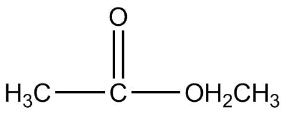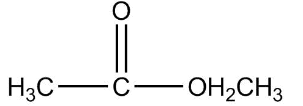
The structural formula of ethyl ethanoate is:
1.

2.

3.

4.





Answer
529.5k+ views
Hint: Ethyl acetic acid derivation, otherwise called ethyl ethanoate is one natural compound and is basically utilized as a dissolvable in various responses. Ethyl acetic acid derivation is acquired from the immediate esterification of ethyl liquor with acidic corrosive, a cycle which includes blending acidic corrosive in with an abundance of ethyl liquor and adding a modest quantity of sulphuric corrosive.
Complete step by step solution:
Now, first of all, understand what is ethyl ethanoate, we will identify the functional group in this compound as we can see that it is clearly an ester as an ester contains two alkyl group on both the sides of a carbon-oxygen bond and the general formula of ether is $RCOOR$. Since the prefix in the compound is ethyl that means the ethyl group is attached to the carbon of the functional group of ester.
So the formula of ethyl is ${C_2}{H_5}$ now the prefix used for the suffix oate is ethane, which means the oxygen of ester functional group is attached with one carbon as one carbon is contained in the general formula already, that means methyl is attached on one side of the functional group.
Therefore the final structure of the ethyl ethanoate compound will be

So the correct answer is 2.
Note: Ethyl acetic acid derivation is just feebly Lewis fundamental. It structures adducts with I2, phenol, and bis (hexafluoroacetylacetonate) copper (II). Ethyl acetic acid derivation hydrolyses to give acidic corrosive and ethanol. Bases quicken the hydrolysis, which is dependent upon the Fischer balance referenced previously. In the research center, and ordinarily for illustrative purposes just, ethyl esters are commonly hydrolyzed in a two-venture measure beginning with a stoichiometric measure of a solid base, for example, sodium hydroxide.
Complete step by step solution:
Now, first of all, understand what is ethyl ethanoate, we will identify the functional group in this compound as we can see that it is clearly an ester as an ester contains two alkyl group on both the sides of a carbon-oxygen bond and the general formula of ether is $RCOOR$. Since the prefix in the compound is ethyl that means the ethyl group is attached to the carbon of the functional group of ester.
So the formula of ethyl is ${C_2}{H_5}$ now the prefix used for the suffix oate is ethane, which means the oxygen of ester functional group is attached with one carbon as one carbon is contained in the general formula already, that means methyl is attached on one side of the functional group.
Therefore the final structure of the ethyl ethanoate compound will be

So the correct answer is 2.
Note: Ethyl acetic acid derivation is just feebly Lewis fundamental. It structures adducts with I2, phenol, and bis (hexafluoroacetylacetonate) copper (II). Ethyl acetic acid derivation hydrolyses to give acidic corrosive and ethanol. Bases quicken the hydrolysis, which is dependent upon the Fischer balance referenced previously. In the research center, and ordinarily for illustrative purposes just, ethyl esters are commonly hydrolyzed in a two-venture measure beginning with a stoichiometric measure of a solid base, for example, sodium hydroxide.
Recently Updated Pages
The number of solutions in x in 02pi for which sqrt class 12 maths CBSE

Write any two methods of preparation of phenol Give class 12 chemistry CBSE

Differentiate between action potential and resting class 12 biology CBSE

Two plane mirrors arranged at right angles to each class 12 physics CBSE

Which of the following molecules is are chiral A I class 12 chemistry CBSE

Name different types of neurons and give one function class 12 biology CBSE

Trending doubts
One Metric ton is equal to kg A 10000 B 1000 C 100 class 11 physics CBSE

Explain zero factorial class 11 maths CBSE

What is 1s 2s 2p 3s 3p class 11 chemistry CBSE

Discuss the various forms of bacteria class 11 biology CBSE

State the laws of reflection of light

Difference Between Prokaryotic Cells and Eukaryotic Cells




